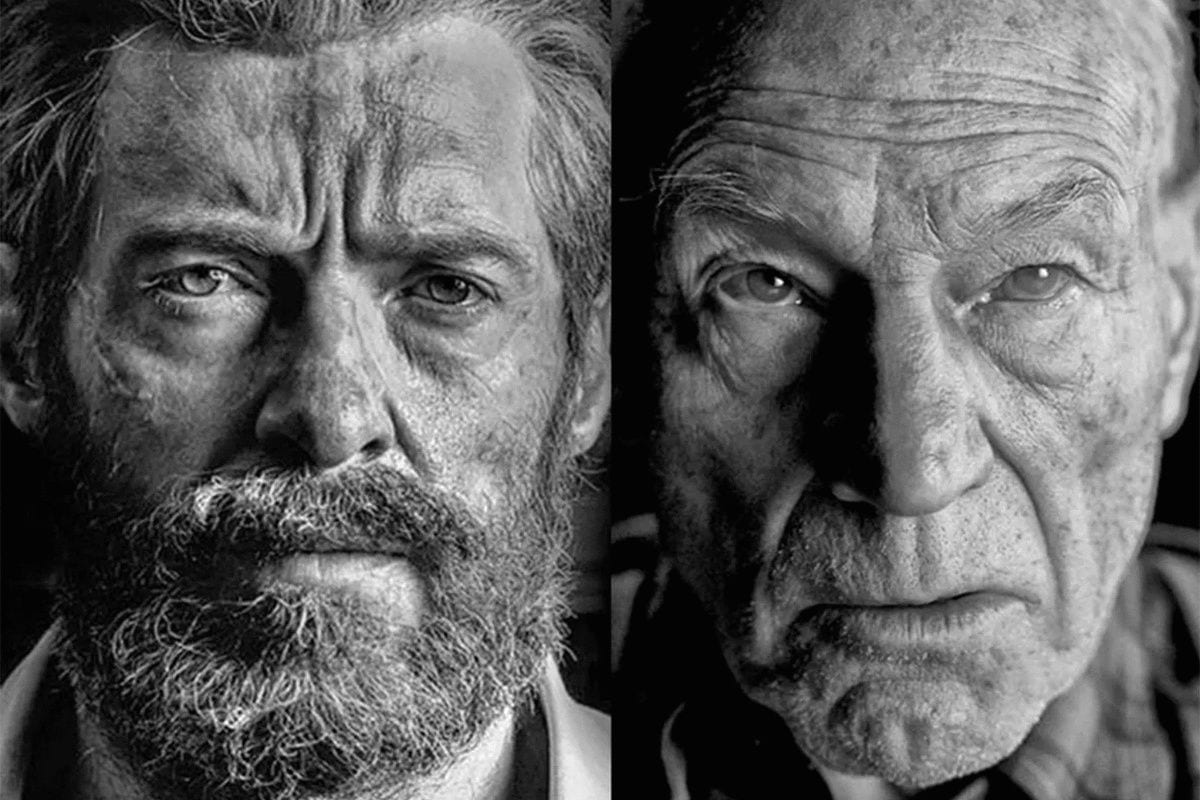Logan/Wolverine, played by Hugh Jackman, first debuted on film as the central character of X-Men (Singer, 2000). In this film, he is a soulful, pained loner with retractable metal claws, super-healing powers, and no memory of his past. He’s pulled into the world of the X-Men by a desire to help a young, runaway mutant girl. In X2: X-Men United (Singer, 2003), he’s again centrally placed as he confronts details of his violent past, but chooses to side with his X-Men family. In X-Men: The Last Stand (Ratner, 2006), Logan is forced to kill his crush, Jean Grey, because she has become too destructively powerful. X-Men Origins: Wolverine (Hood, 2009) fills in Logan’s history, from 19th century Canada through decades of war, gaining his metal skeleton and claws, and the loss of his memory.
He has a brief, funny cameo in the ’60s-set X-Men: First Class (Vaughn, 2011), because it seemed inconceivable at that point to have an X-Men film without Logan. The Wolverine (Mangold, 2013) finds Logan struggling with the loss of Jean and burdened by the compounded suffering of endless life. X-Men: Days of Future Past (Singer, 2014) takes Logan through a time travel romp, bridging the original X-Men cast in the 2020s with the newer X-Men cast in the 1970s. Finally, the ’80s-set X-Men: Apocalypse (Singer, 2016) reimagined Logan’s traumatic metal skeleton-grafting and brainwashing one more time for a memorable but superfluous sequence. These eight appearances over 16 years create a deep cinematic history for the character and strong familiarity with audiences.
The filmmakers behind Logan (Mangold, 2017) were only passingly interested in this history, however. Previous appearances somewhat informed their approach, and the familiarity certainly helped the film resonate with audiences; however, the filmmakers had a very specific, emotionally raw story to tell and were not overly concerned with continuity or superhero tropes.
In late 2013, following the creatively satisfying but not commercially successful The Wolverine, writer-director James Mangold and Hugh Jackman began negotiations for another Wolverine film. Mangold was determined not to repeat himself, or other superhero films for that matter, on the next film. Jackman, meanwhile, was strongly considering ending his long tenure as Logan. The idea, then, was to make the final Wolverine film, his last story. Everything that entailed meant that this would be a very different film. They pitched to Fox Studios, a new approach: darker, more violent, more standalone, less beholden to previous films and, above all, an ending for the character.
The idea of Logan at the end of his life led Mangold to draw some inspiration from “Old Man Logan”, a storyline created by Mark Millar and Steve McNiven for the Wolverine comic book series from 2008 to 2009. That story takes place in a desolate future dystopia, where Logan has become a pacifist after the violent deaths of the X-Men, and goes on a road trip through the United States with another Marvel superhero. These elements all made it into the film, but the main plot and other, more “comic book-y” elements were rejected for more raw, grounded emotion.
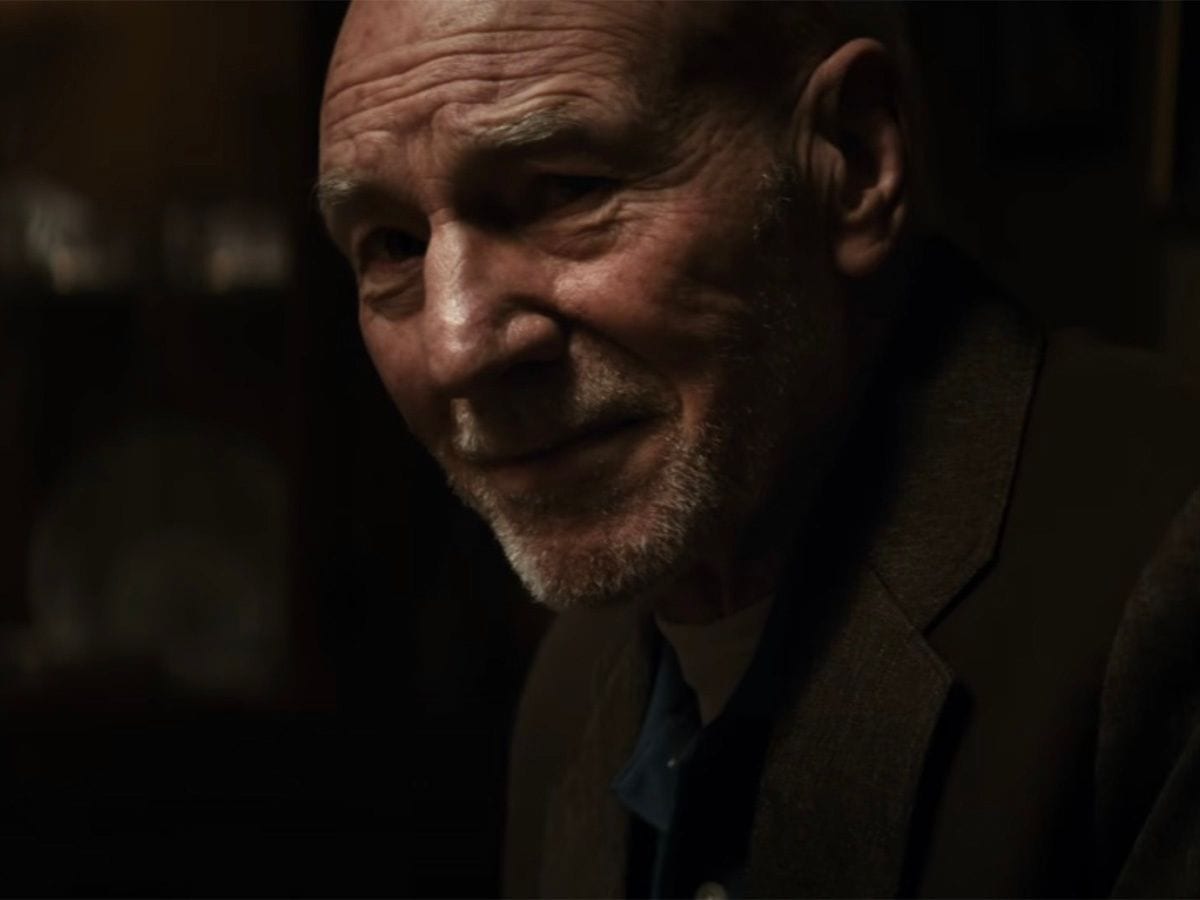
Patrick Stuart as Charles (IMDB)
Overall, Mangold intended to make his new film different by avoiding as many superhero film tropes as possible. His co-writer, Scott Frank, set the tone for the approach when he told Mangold that the film would not be “a hyper choreographed, gravity defying, city-block destroying, CG f–athon.” He went on to say, “In this flick, people will get hurt or killed if they get hit with something big and heavy like, say, a car. Should anyone in our story have the misfortune to fall off a roof or out a window, they won’t bounce. They will die.”
Mangold insisted the studio agree to an R-rating on the film, but not simply to provide more allowance for violence or swearing. Mangold felt that an R-rated film was freed from certain studio or marketing expectations, that he would not be urged to shorten scenes or mediate his mature tone to appeal to teen audiences. Fox allowed the R-rating in exchange for a budget cut, imagining the rating would limit the box office potential of the film. Mangold actively avoided broad heroic moments. His heroes would be weak, physically and emotionally. They would be fearful of danger, they would selfishly resist heroics, they would undermine or question past heroics. Previous films would be referenced only if it helped the story, not simply for fan service.
For these reasons, attempts to include older versions of Rogue, Jean Grey or Sabretooth were ultimately cut by the screenwriters because they rang false. The filmmakers even went so far as to omit “Wolverine” from the title of the film, sacrificing audience recognition for their vision. Every aspect of the approach was a direct rebuke of the conventional superhero film formula.
But a film cannot be successful by simply defining itself in opposition to convention. The standard superhero film formula is widespread because it works, audiences respond to it. For Logan to work it needed a strong emotional core and clear themes. Mangold, Frank and other co-writer Michael Green delivered that in spades. With this being the final Wolverine film, they confronted the character with his biggest fear: familial love.
As an older man, slowly dying, Logan has to reckon with what his life represents. He has a violent past and worries that everyone who loves him dies as a result. He begins in the film looking after Professor Xavier (Patrick Stewart), a powerful telepath and father figure to him, who is now raving from dementia. Soon, Logan meets Laura (Dafne Keen), his scientifically-created daughter. This elderly, sick surrogate father and this young, estranged, emotionally-scarred daughter come to rely entirely on Logan, a haunted, battered, suicidal husk. This is Logan’s worst nightmare.
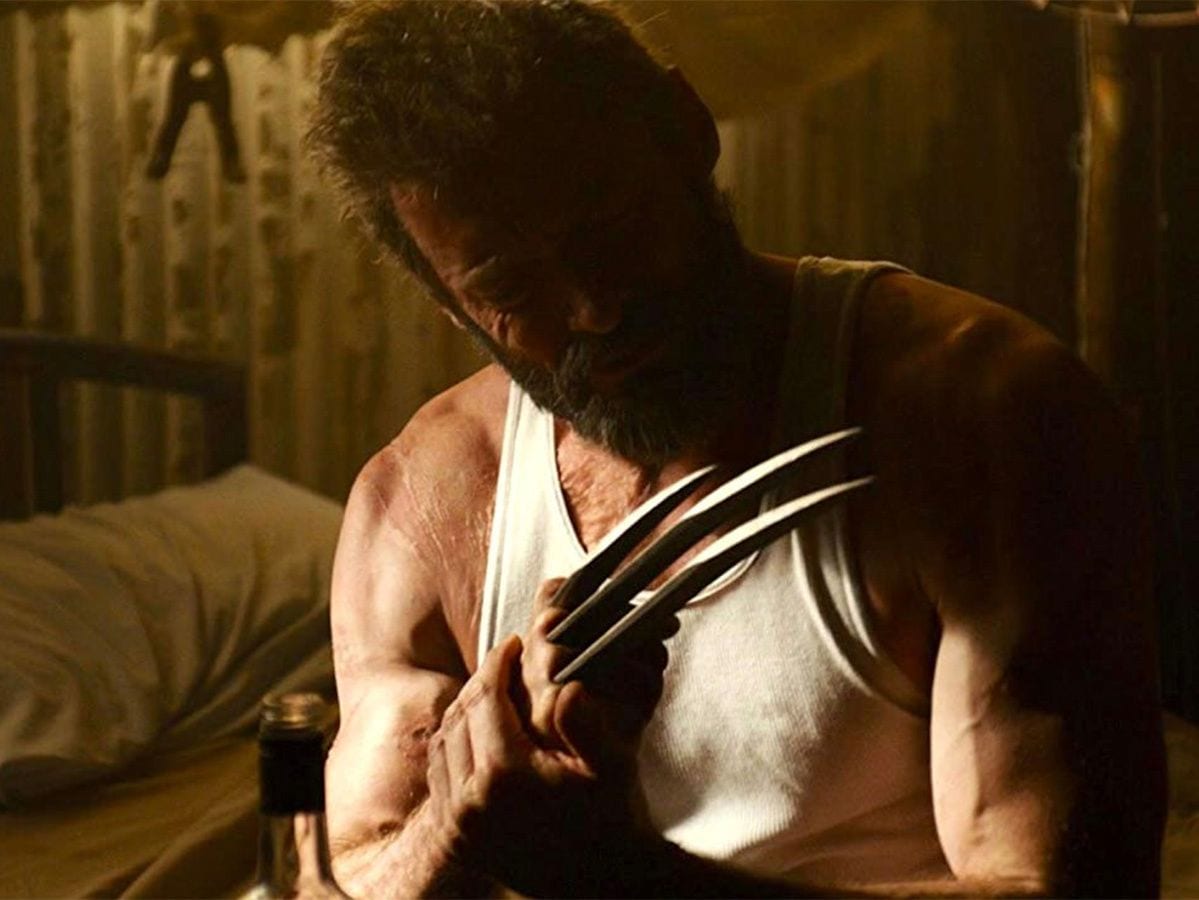
Hugh Jackman as Logan / X-24 (IMDB)
Laura is based on X-23, a female clone of Wolverine. The character first appeared in the animated series X-Men: Evolution in August 2003, then appeared in comics in NYX #3 (February 2004). She became popular in the comics, appearing in limited series and team books over the years. Elements of the comic version of X-23 also make their way into the character X-24 (Hugh Jackman) in Logan. X-24 is a mindless, angry adult clone of Logan, the literal incarnation of Logan’s violent past that now hunts his family unit. And so Logan must accept and defend the love he is given by Xavier and Laura, while reckoning with his past.
Logan is a dark, intense, emotionally-charged film. It replaces the conventional tropes of a superhero film with a meditation on violence, loss, aging, family, life and death. Mangold was inspired by reflective, emotional Western films such as Shane (Stevens, 1953) and Unforgiven (Eastwood, 1992). In both films, former gunfighters are pulled back into the violence of their past while philosophizing about the effect of such violence on a person’s soul.
He was also inspired by the emotional realism of the family road trip comedy Little Miss Sunshine (Dayton & Faris, 2006). In October 2016, a brilliant teaser trailer set to “Hurt” by Johnny Cash introduced the bleak, grounded, intense tone of Logan to audiences. Logan is a comic book superhero film that actively bucked nearly every convention of the genre. Perhaps ironically, the film is considered one of the finest examples of the genre ever made.
Logan opens with the flipping comic pages of the Marvel logo that has opened MCU films since 2002, but this time every page is clearly from an X-Men comic. It’s funny that the logo on Logan celebrates X-Men comics, considering the film itself is not overly concerned with the comics. Logan is set in 2029, and the future elements are subtly layered. There seems to be a border wall between Texas and Mexico, something that was beginning to be discussed in the news as the film was being produced. The mutant population seems to be on the decline. Cars look a little different, and the highways are filled with self-driving trucks. Overall, the future in the film feels like only a slight extension of the present day. Mangold wanted the film to be set in the future so it could address Logan’s aging, but he didn’t want it to be too showy.
Logan works as a limo driver-for-hire in south Texas. He first appears sleeping in the back of the limo, when a group of men attempt to steal his tires. His first line is “fuck”, something that he will frequently repeat throughout the film, and he attempts to peacefully stop the tire thieves. When they shoot him in the chest with a shotgun, he attacks them with his claws, although the claws have trouble fully extending. In the fight he seems more concerned with protecting the limo from damage than his own body.
Afterward he drives to a rest stop bathroom to heal and change his bloodied shirt. The healing takes longer now that he’s older, and his body shows more wear than one would expect from the famous fast-healing mutant. He walks with a limp and his eyesight is going. He looks grizzled and old, drinks too much, and buys drugs illegally from a hospital employee. He lives across the Mexican border in a dingy abandoned refinery, where he drinks and suffers from insomnia. Above his bed hangs a samurai sword, possibly referencing The Wolverine and better times. We learn that the adamantium grafted to his skeleton is slowly poisoning him, and he carries an adamantium bullet capable of killing him. Jackman’s performance is credible and grounded, and Logan is presented in a refreshingly unglamourous light.
He lives in the refinery with Caliban (Stephen Merchant), an albino tracking mutant, and Xavier, who is suffering from dementia. In X-Men: Apocalypse, the previous X-Men film, Caliban was a very different character played by a different actor and Xavier lost his hair. That Caliban is so different here and Xavier has some hair indicates just how little the filmmakers cared for continuity with other films.
Stewart is magnificent as Xavier in Logan. He is confused by his dementia, sometimes does not recognize Logan, and rambles nearly incoherently. He cannot control his powerful telepathy and, if not given the proper drugs, he has seizures that and telepathically freeze and even kill anyone who’s nearby. We later learn that one of the seizures killed the X-Men a year earlier, prompting Logan to isolate Xavier in the refinery. Xavier doesn’t remember the so-called “Westchester Incident”, and Logan doesn’t remind him. Instead, Xavier is angry at the confinement, spewing insults at Logan, blaming him, and refusing to take his medication.
They bicker like a real elderly parent and aging child. Logan is steadfast in helping his surrogate father, carrying him into bed or to the bathroom. I have some experience caring for a disabled parent, so these scenes hit close to home. This early section of Logan plays nothing like a superhero film, but more like a domestic drama. Its muted and bleak, and engages with realistic problems such as aging, illness, caring for a sick parent, and money concerns. In Logan’s case, he plans to buy a boat for himself and Xavier to that they may live on the water, away from anyone they could hurt. These are our superheroes, far from their former glory.
Logan is then confronted by Gabriela (Elizabeth Rodriguez), who knows of his past and wants to hire him to drive her and her daughter, Laura, to North Dakota. By contacting Logan, Gabriela brings him to the attention of Donald Pierce (Boyd Holbrook) and his employers. Logan is hesitant at first, but decides to help Gabriela, as this is how he will the money he needs to buy the boat. When he arrives to pick her up, he finds Gabriela dead and recovers her phone.
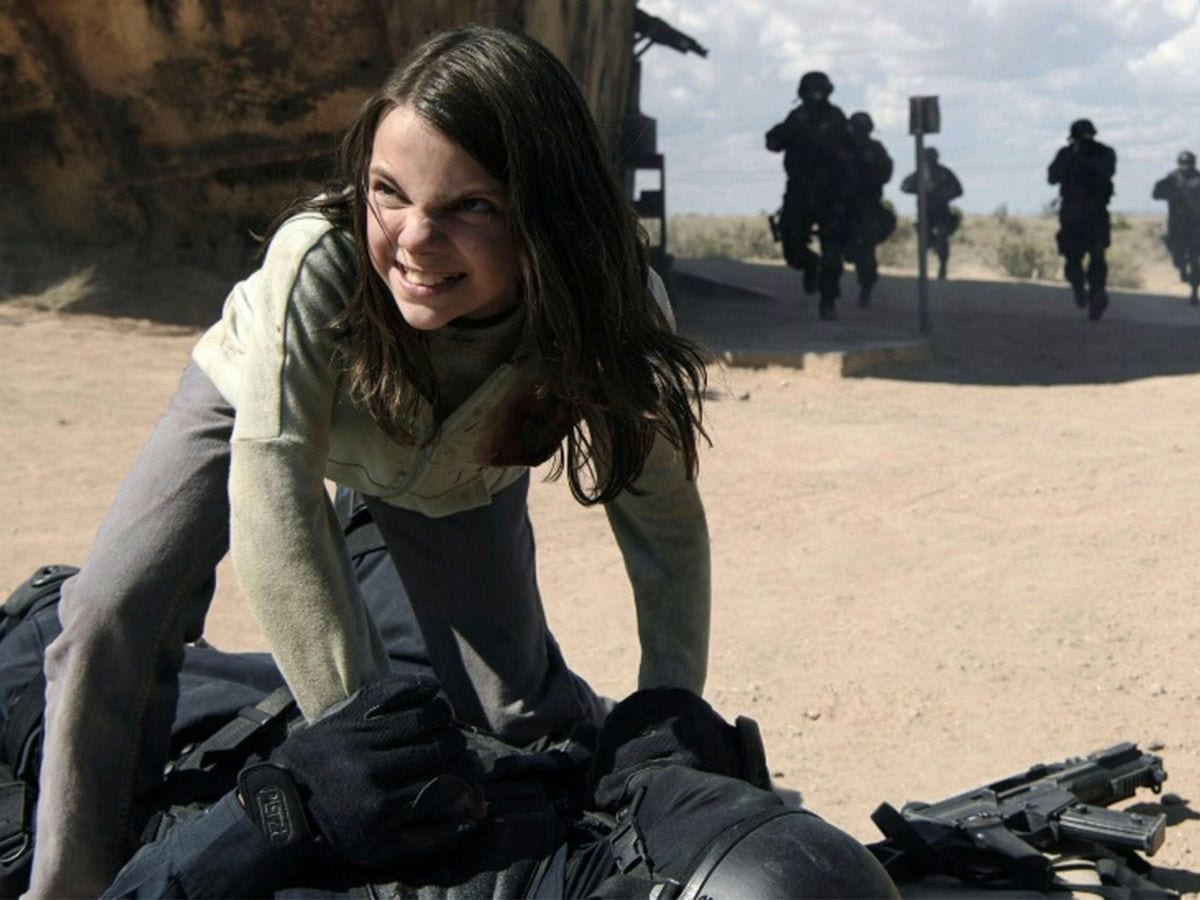
Dafne Keen as Laura (Amazon)
Back at the refinery, he discovers that Laura stowed away in the trunk of his car. Xavier is elated, insisting that Laura is a mutant and that they must protect her. Then Pierce arrives with his team of mercenary Reavers, and Logan’s attempt to live quietly under the radar is shattered.
It’s important to note how hard Logan swims against the current of the plot. He doesn’t care about Laura or her connection to the Reavers, he doesn’t want to get involved. Even when things explode into violence, all he cares apart is getting himself and Xavier to safety. And then, Laura pops her adamantium claws.
Laura is wild, nearly feral. She brutally attacks the Reavers as Logan attempts to drive away. The violence in the film is harsh and shocking. The R-rating not only allows the film to depict this brutal violence (claws through arms and skulls, lost limbs, decapitations), but also the consequences of that violence. PG-13 violence tends to match the brutality of R violence but with less responsibly. All the violence will be depicted, but with none of the blood, gore or consequences. Logan doesn’t have that problem.
It’s difficult to watch Laura in these fights. I can accept the portrayal of an adult man jumping around, brutally killing bad guys, spattered in blood, but an 11-year-old girl in the same position makes me uncomfortable, which is part of the point. Logan becomes curious about Laura during the fight, and accepts her into his car. And then, in possibly the clearest example of the grounded nature of Mangold’s approach, Logan drives his car at a fence in his attempt to escape, and the fence stops him. He doesn’t burst through and triumphantly drive to safety, he’s caught and must find another way out. Eventually he get aways, and the film becomes a road trip film with the dysfunctional family unit of Xavier, Laura, and Logan.
Logan learns about Laura through videos on Gabriela’s phone. A scientist, Dr. Rice (Richard E. Grant), started a lab in Mexico where he impregnated poor Mexican women with mutant DNA to create new mutants. These children were raised and trained to be weapons. When they became too unstable and rebellious, Rice began a new program and ordered the children killed.
Gabriela and the other nurses attempted to save the children and smuggle them to safety in Canada. Laura was created from Logan’s DNA, making her Logan’s daughter. As Gabriela puts it to Logan in the video, “you may not love her, but she’s your daughter.” Dafne Keen is astonishing as Laura. In action scenes, she is acrobatic and vicious, channelling Jackman as an 11-year old girl. In between the action is where she really shines, however.
She doesn’t even speak for most of the film, with her muteness conveying the trauma of her short life. As she moves through the road trip, she sadly rides a coin-operated horse and grabs a pair of pink sunglasses. These are things that a girl of her age might do, but she doesn’t know how to be a regular child. She learns how to hold Logan’s hand from her observation of a mannequin display.
Mangold is heavily inspired by Westerns. But to paraphrase the commentary on the 20th Century Fox Blu-ray released in 2017, it’s not the specific trappings of a Western (gunfights, deserts, etc.) that appeal to him, but the simplicity of such plots paired with a complexity of characters. This element of Logan is a more subtle, structural rebuke of superhero film tropes. A conventional superhero film can often include overly-intricate plot mechanics and an abundance of McGuffins while sketching characters out as broad archetypes. Logan does the opposite.
The plot is simple: Logan must get Laura to the Canadian border to escape the men who created her. The characters are far from simple, however. Logan is haunted by his past, does not envisage much of a future, and he’s now confronted with a surprise daughter. Laura knows little beyond trauma and abuse in a lab, but makes an emotional connection with Logan. Xavier sees Laura as his final chance to foster a young mutant, but also comes to remember the sins of his past.
The other key aspect of Mangold’s Westerns-influenced approach is how much of the story in Logan is unspoken, subtextual. Mangold and his collaborators put the characters in various situations that highlight their struggles, and the rest is left up to the performances of the gifted cast. As much as I love comic book superhero films, this being my 43rd article on the Marvel Films, Logan absolutely stands out from the others due to its sombre, subtle, character-driven dramatics. Previous films seemed to establish the rules only so Logan could so brilliantly oppose them.
The trio’s first major stop is at a hotel and casino in Oklahoma City, where Xavier and Laura watch the TV Western, Shane, as Logan makes arrangements. Logan finds some X-Men comics, loosely based on the adventures of Logan and the X-Men, and he’s at first disgusted by their glorifications and falsehoods. He flips through one to discover the coordinates given to him by Gabriela are from a comic, meaning that Laura’s destination is likely a lie. As Xavier points out, however, it’s real for Laura, so Logan continues the trip despite misgivings.
But first, Pierce finds them at the hotel. Logan returns to discover Xavier is having a seizure, telepathically paralyzing and hurting everyone in the hotel. Logan’s healing power makes him resistant to Xavier’s destruction, and he battles through the telepathic shockwaves to deliver Xavier’s medicine. On the way, he kills Pierce’s men in their hotel room. It’s an excruciating scene, as Logan slowly moves to each man and dispatches them, as they are unable to defend themselves. The trio rushes to escape, but Xavier is devastated by the pain he caused his unwitting victim.
Back on the road, the trio witnesses a truck and its horse trailer driven off the road by a driverless truck. Xavier urges Logan to help, which he does, and then to accept the grateful man’s invitation to dinner at the family’s farm. Will (Eriq La Salle) and Kathryn (Elise Neal) Munson, and their son Nate (Quincy Fouse), own a farm that is being squeezed out by corporate farms. The dinner is a happy, warm scene in set on a sea of bleak violence. Xavier does most of the talking, normalizing himself by claiming they are a grandfather, father, and daughter out to see America on the road. Xavier hopes the dinner, and his insistence to stay overnight, will inspire Logan with the possibility of a normal life. But the bleak violence and the character’s demons follow them to the farm, in a shocking, heartbreaking sequence.
At the farmhouse, Logan helps Will fix a sabotaged water pump, and he threatens men who try to intimidate Will. At one point Xavier senses Logan in his room and praises the “perfect night” he is experiencing at the farmhouse before tearfully admitting that he doesn’t deserve it. He remembers that his seizures killed the X-Men a year earlier. But his tragic remembrance is interrupted by the even more tragic twist: the man he senses standing in his room is not Logan, but X-24, a mindless, violent clone of Logan created by Dr. Rice.
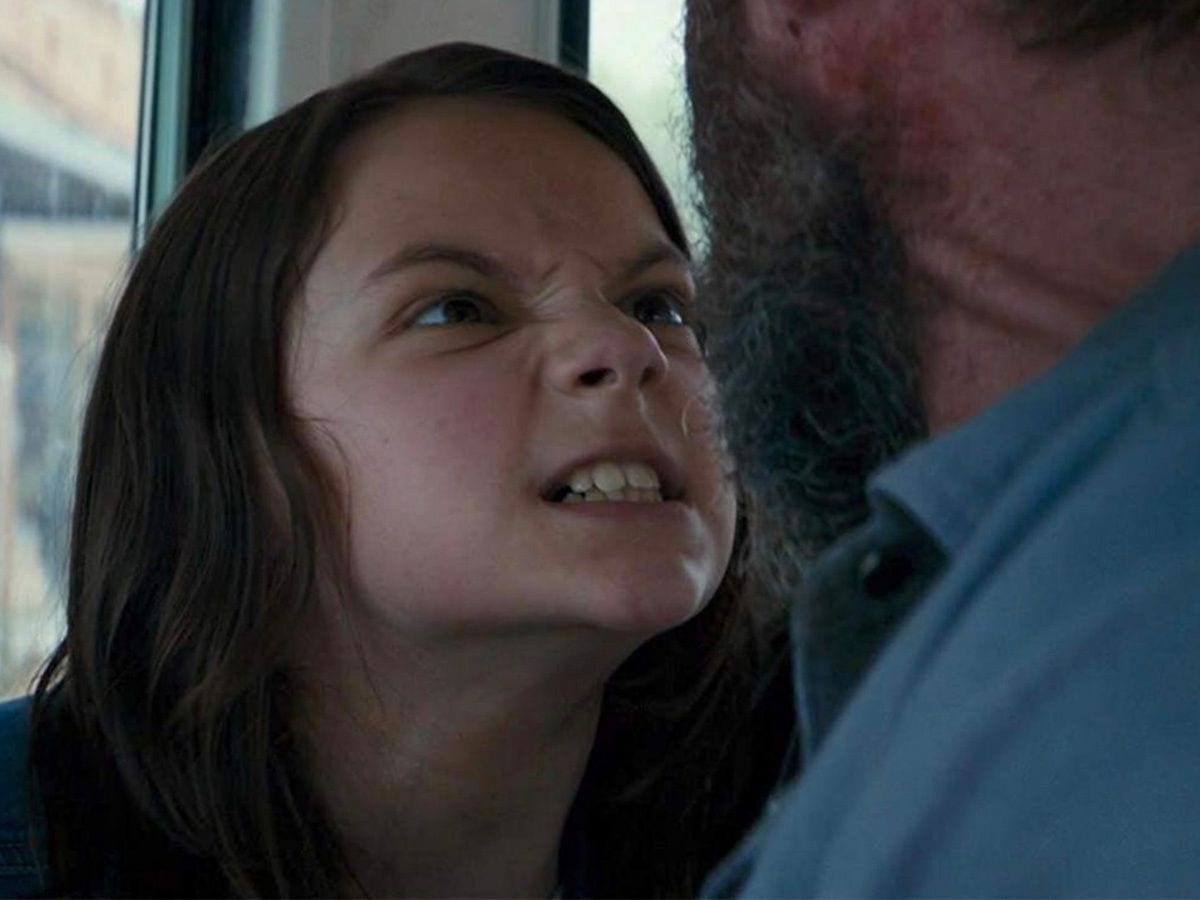
Dafne King as Laura (IMDB)
X-24 kills Xavier, Nate, and Kathryn before taking Laura back to Rice. Chaos erupts as he attacks Will, and Logan fights him. Logan has difficulty defeating his younger, fitter clone until an injured Will drives his truck into X-24 and pumps him with shotgun blasts. Logan takes Laura and Xavier’s body, and escapes. But by then X-24 has murdered the family. The message behind the brutality of this scene is clear: Logan can never escape his past, he can never have a normal life. That Will tried to shoot Logan after shooting X-24, not differentiating between them, demonstrates that Logan will always be accountable for his past. The shocking violence in the sequence, especially against such undeserving characters, is off-putting but it underscores the character themes. It’s realistically horrible, not glorified in the least.
The death of Xavier is shocking for many reasons. This is a classic Marvel hero of comics and films, killed in bed as an old man with dementia. In Logan, there is no glory in death, just sorrow. Logan and Laura stop to bury Xavier. Logan tries to eulogize him, but cannot find the words. He chokes up, pulls away from Laura’s hand and attacks their truck with a shovel before passing out from the pain of his fight wounds. The scene is sad and real, even funny in its own way.
At this point, she fully takes over the film. She speaks for the first time, unloading her frustration with Logan in Spanish for refusing to take her the rest of the way. Logan relents, but keeps passing out as he drives. Laura will not let him die. She gets him to her destination, where she finds a hideout with other mutant children from her lab. They help to heal Logan with small doses of a mysterious green chemical, and make their plans to cross the border together. They later shave Logan’s scruffy beard while he’s passed out, to make him resemble his classic X-Men look, but he’s not amused.
The scenes between Laura and Logan at this point allow some of Jackman’s finest acting work. Laura says that she has nightmares about people hurting her, and Logan says that, in his nightmares, he hurts people. Laura says that she has hurt people too, but they were all bad people. Logan insists that she will have to come to terms with that eventually. Without saying it, Laura makes it clear that she is upset Logan will not accompany them over the border. Logan tearfully tells her that she has everything she wants, that she should go without him because “bad shit happens to people that care about me.” Laura replies, “then I’ll be fine.”
When I first saw Logan, my daughter was less than a year old, barely a toddler. She is three now, but already her own person. So, on this viewing of Logan, my heart ached at the father-daughter interplay at work here. I understood the complexities of seeing yourself, good and bad, reflected in a child, of seeing your attitude directed back at you, of trying to encourage your child to be better than you. As my daughter grows, Logan becomes more resonant and more heartbreaking in my mind. Needless to say, this is atypical of standard superhero films.
Logan wakes to find that Rice and Pierce are following them. He takes a full dosage of the green chemical to temporarily recharge his healing and strength. For the only time in the film, Logan goes full berserker “Wolverine,” and fights back-to-back with Laura. The sequence should be rousing, but it doesn’t play that way because we know the stakes. The chemical will likely be too much for Logan’s body, and he doesn’t want Laura immersed in such violence her whole life. Thus, the triumphant action is tinged with sadness.
The chemical wears off, and Rice confronts Logan. He explains that Logan killed his father long ago, and that his GMOs have caused the end of mutants. In response, Logan shoots him in the head. This is the kind of backstory that most superhero films would take ages to carefully lay out, but neither Logan nor the film care. X-24 attacks, and Logan cannot keep up. Laura attacks him too but is thrown aside. X-24 impales Logan on the root of a dead tree. Laura then takes the adamantium bullet, the one Logan meant to use to kill himself, and revived, shoots X-24 in the head. Narratively, Logan’s evil clone is killed by his lab-created daughter. Thematically, the angry, violent embodiment of Logan’s past sins is destroyed by the embodiment of his best qualities and potential, bringing him a few moments of peace. Possibly hope.
Those few moments, however, are his last. He urges Laura to escape and to stop this life of fighting. He tells her not to be what they made her. Laura cries and calls him “daddy”. Logan’s final line, “so this is what it feels like,” refers both to the death that has eluded him for nearly two centuries and the feeling of pure, familial love. His death is violent, yet beautifully peaceful.
Laura and her friends bury him, and the only thing that can think to say is a speech from the end of Shane. It’s about the impact killing other has on your soul. As everyone leaves, Laura turns the cross marking Logan’s grave to an ‘X’. Cue tears, and Johnny Cash’s “The Man Comes Around”. These final moments of Logan are pitch perfect, absolutely gorgeous. They close an unconventional superhero film with the biggest inversion of superhero tropes imaginable: an ending.
The majority of superhero comics, by their nature, feature ongoing serialization. There exists a status quo for each character. Sometimes new stories will disrupt that status quo, introducing major changes or character deaths, to open up story possibilities, but the status quo is nearly always restored. Superhero films inherited the idea of never having a definitive ending, always leaving the door open for a sequel. The Dark Knight Rises (Nolan, 2012) was the definitive end of Christopher Nolan’s celebrated Dark Knight trilogy, and seems to kill Batman. But even that film ultimately ends with Bruce Wayne alive, but retired, and Joseph Gordon-Levitt’s character seeming to take up the Batman mantle. Had they wanted to, the filmmakers could have made another sequel.
Even Avengers: Endgame (Russo Brothers, 2019) seems to definitively kill the Black Widow character, yet her first solo film, Black Widow (Shortland, 2020), debuts in May. There’s always room for a new installment. To be fair, Iron Man did indeed die in Endgame, which would still only make him second to Logan in terms of cinematic superhero deaths. Hugh Jackman portrayed Logan/Wolverine in nine films over 17 years before the character was finally killed.
For its ending, as well as the rest of it, Logan is an incredible film. It’s brutal, bleak and violent, but also adult, mature, and emotionally genuine. It explores the legacy of a superhero, the toll such a life takes on the body and soul, and the ignoble, sorrowful, inglorious endings of a hero. It does so by eschewing the classic, well-established tropes of the superhero genre. And in opposing the tropes, it ended up becoming one of the greatest of the genre.
Logan was critically-acclaimed upon release, landing on numerous top-ten lists of 2017 and became the first superhero film to be nominated for Best Screenplay (Adapted) at the Academy Awards. Audiences are smarter than most marketing departments give them credit for, as Logan was the highest-grossing of the three Wolverine films despite not having “Wolverine” in the title. It earned over $226 million in North America and $619 million worldwide. The budget was lowered to under $100 million due to studio concerns over the rating, which only accentuates the windfall.
Jackman’s last performance as the iconic character, and his presumed death at the end, drove many people to the theatres. In Logan, Jackman and Stewart said goodbye to their famous roles, but a lot of people expressed interest in Keen continuing Laura’s story in future films. The Disney/Fox merger seems to have ended that speculation, however. All in all, Mangold and his collaborators succeeded beyond all expectations, and proved that even superhero films can be mature, can feel emotionally-real, and can, at last, end.
Stan Lee Cameo Corner: Mangold avoided many superhero tropes, including a Stan Lee cameo. That is 28 cameos in 43 films.
Credits Scene(s): Mangold hates the idea of post-credits scenes, either telling more story beyond the ending or trying to sell the next film. So, not surprisingly, Logan has no scenes during or after the credits.
Next Time: On a lighter note, cue the Walkman because the Guardians of the Galaxy are back.
- X-Men: Days of Future Past Restored the Series to Its Glory ...
- Love Disinterest: "Savage Wolverine #6" - PopMatters
- Playing the Piper: Wolverine & the X-Men #4 - PopMatters
- Pride and Mourning: "Death of Wolverine: The Logan Legacy #2 ...
- X-Men Origins: Wolverine - PopMatters
- A Fitting (But Incomplete) End: "Death of Wolverine #4" - PopMatters
- Return of Wolverine #1, Marvel (comics review) - PopMatters
- Mortal Dynamics: "Wolverine #1" - PopMatters
- 'X-men-Origins: Wolverine' Can't Tell Which Story to Tell - PopMatters
- 'The Wolverine': Not So X-Men - PopMatters
- James Mangold comes to the rescue of 'Knight and Day' | PopMatters
- 'The Wolverine' Is a Stranger in a Strange Land - PopMatters
- Killing Is Killing: Logan's Enduring Excellence - PopMatters
- Bloody 'Logan' Is a Worthy Sendoff for Hugh Jackman - PopMatters

